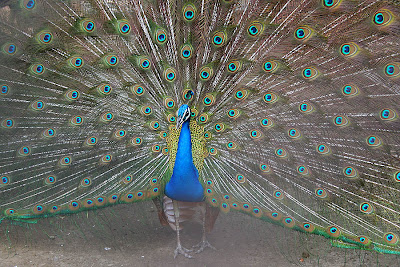The Indian Peafowl or Blue Peafowl (Pavo cristatus) is a large and brightly coloured bird of the pheasant family native to South Asia, but introduced and semi-feral in many other parts of the world. The male, peacock, is predominantly blue with a fan-like crest of spatula-tipped wire-like feathers and is best known for the long train made up of elongated upper-tail covert feathers which bear colourful eyespots. These stiff and elongated feathers are raised into a fan and quivered in a display during courtship. The female lacks the train, has a greenish lower neck and has a duller brown plumage. They are found mainly on the ground in open forest or cultivation where they forage for berries, grains but will also prey on snakes, lizards, and small rodents. Their loud calls make them easy to detect, and in forest areas, often indicate the presence of a predator such as a tiger. They forage on the ground, moving in small groups and will usually try to escape on foot through undergrowth and avoid flying. They will fly up into tall trees to roost, however. It is the national bird of India.
The male, known as a peacock, is a large bird with a length from bill to tail of 100 to 115 cm (40 to 46 inches) and to the end of a fully grown train as much as 195 to 225 cm (78 to 90 inches) and weigh 4–6 kg (8.8-13.2 lbs). The females, or peahens, are smaller at around 95 cm (38 inches) in length and weigh 2.75–4 kg (6-8.8 lbs). Their size, colour and shape of crest make them unmistakable within their native distribution range. The male is metallic blue on the crown, the feathers of the head being short and curled. The fan-shaped crest on the head is made of feathers with bare black shafts and tipped with blush-green webbing. A white stripe above the eye and a crescent shaped white patch below the eye are formed by bare white skin. The sides of the head have iridescent greenish blue feathers. The back has scaly bronze-green feathers with black and copper markings. The scapular and the wings are buff and barred in black, the primaries are chestnut and the secondaries are black. The tail is dark brown and the "train" is made up by elongated upper tail coverts (more than 200 feathers, the actual tail has only 20 feathers) and nearly all of these feathers end with an elaborate eye-spot. A few of the outer feathers lack the spot and end in a crescent shaped black tip. The underside is dark glossy green shading into blackish under the tail. The thighs are buff coloured. The male has a spur on the leg above the hind toe.
The adult peahen has a rufous-brown head with a crest as in the male but the tips chestnut edged with green. The upper body is brownish with paler mottling. The primaries, secondaries and tail are dark brown. The lower neck is metallic green and the breast feathers are dark brown glossed with green. The rest of the underparts are whitish. Downy young are pale buff with a dark brown mark on the nape connecting with the eyes.Young males looks like the females but the wings are chestnut coloured.
The Indian Peafowl is a resident breeder across the Indian subcontinent and is found in the drier lowland areas of Sri Lanka. In South Asia, it is found mainly below an altitude of 1800 m and in rare cases seen at about 2000m. It is found in moist and dry-deciduous forests, but can adapt to live in cultivated regions and around human habitations and is usually found where water is available. In many parts of northern India, they are protected by religious sentiment and will forage around villages and towns for scraps. while others suggest that the bird had reached Athens by 450 BC and may have been introduced even earlier. It has since been introduced in many other parts of the world and has become feral in some areas.
Peafowl are omnivorous and eat seeds, insects , fruits, small mammals and reptiles. They feed on small snakes but keep their distance from larger ones. In the Gir forest of Gujarat, are large percent of their food is made up of the fallen berries of Zizyphus.Around cultivated areas, peafowl feed on a wide range of crops such as groundnut, tomato, paddy, chilly and even bananas. Around human habitations, they feed on a variety of food scraps and even human excreta.
The Indian Peafowl have been known to live for 23 years but it is estimated that they live for only about 15 years in the wild.



No comments:
Post a Comment